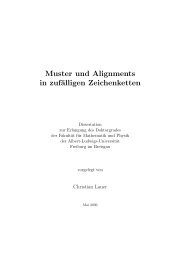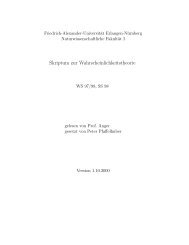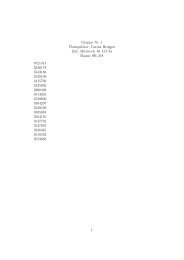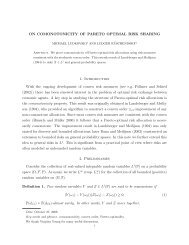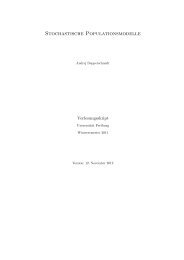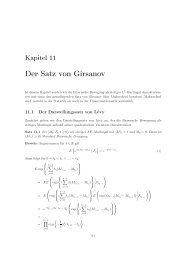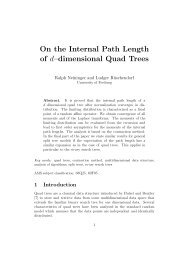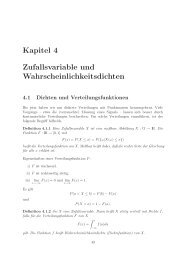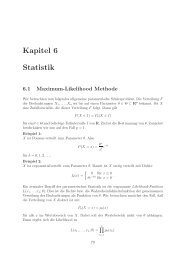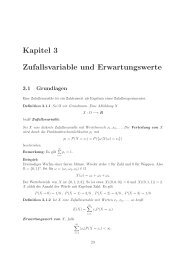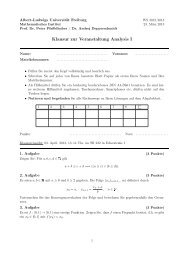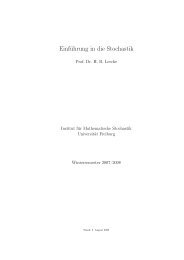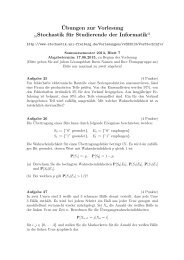Analysis of Markov chain algorithms on spanning trees, rooted ...
Analysis of Markov chain algorithms on spanning trees, rooted ...
Analysis of Markov chain algorithms on spanning trees, rooted ...
You also want an ePaper? Increase the reach of your titles
YUMPU automatically turns print PDFs into web optimized ePapers that Google loves.
J. Fehrenbach and L. Rüschendorf 13<br />
we set B v := (B \ {b}) ∪ {a} and ¯B v := B v . Then B v := P Bv<br />
satisfies (i) by<br />
¯Bv<br />
definiti<strong>on</strong> <str<strong>on</strong>g>of</str<strong>on</strong>g> F G<br />
. To ensure (ii), we show<br />
⋃<br />
B w . (3.5)<br />
p∈B<br />
V(p) = ⋃ w∈D<br />
This gives immediately (ii):<br />
∑<br />
p∈B<br />
F G<br />
(p) = ∑ p∈B<br />
∑<br />
p ′ ∈V(p)<br />
1<br />
|D| F G (p′ ) = ∑ ∑ 1<br />
|D| F G (p′ ).<br />
v∈D p ′ ∈B v<br />
While in (3.5) ⋃ V(p) ⊆ ⋃ ⋃ ⋃<br />
B w is a c<strong>on</strong>sequence <str<strong>on</strong>g>of</str<strong>on</strong>g> the c<strong>on</strong>structi<strong>on</strong> <str<strong>on</strong>g>of</str<strong>on</strong>g> F G<br />
,<br />
V(p) ⊇ Bw <strong>on</strong>e obtains as follows: Take p ∈ B and p ′ ∈ V(p), which is<br />
based <strong>on</strong> p via a node w ∈ D. If e /∈ {a, b}, p ′ is extended to p by adding the<br />
exchange <str<strong>on</strong>g>of</str<strong>on</strong>g> a and b at the first step. By definiti<strong>on</strong> <str<strong>on</strong>g>of</str<strong>on</strong>g> B, p leaves the <strong>spanning</strong><br />
tree B = B v by exchanging e. The same holds, therefore, for p ′ . But in p ′ this<br />
transiti<strong>on</strong> is coded by ¯B ′ := ( ¯B \ {a}) ∪ {b} and so p ′ ∈ B(B v , ¯B v , e) = B v .<br />
If e ∈ {a, b} we get p ∈ P B ¯B,<br />
because a, b are exchanged first in p. Thus the<br />
path p ′ is a path from B ′ := (B \ {b}) ∪ {a} = B v to ¯B = B v and hence<br />
p ′ ∈ B v = P Bv<br />
. ¯Bv<br />
The case d min = 3 we treat analog<strong>on</strong>sly. For v ∈ D let w.l.o.g. a, b ∈ B<br />
and c ∈ ¯B be the tree edges at v in M. We further define B v := B, ¯Ba v :=<br />
( ¯B \ {c}) ∪ {a} and ¯B v b := ( ¯B \ {c}) ∪ {b}. Let X, Y ∈ ST(G) be the start<br />
and end node <str<strong>on</strong>g>of</str<strong>on</strong>g> a path p ∈ B that is based <strong>on</strong> p ′ ∈ V(p) via a node w ∈ D.<br />
We c<strong>on</strong>sider at first e /∈ {a, b, c} and again w.l.o.g. a, b ∈ X, c ∈ Y . According<br />
to the c<strong>on</strong>structi<strong>on</strong> <str<strong>on</strong>g>of</str<strong>on</strong>g> F G<br />
, the edges a, b, and c are exchanged in p in two<br />
c<strong>on</strong>secutive transiti<strong>on</strong>s. Because a, b ∈ B, both edges are either in X or in<br />
Y . The <strong>on</strong>ly circle in X ∪ {c} c<strong>on</strong>tains either a or b. If it c<strong>on</strong>tains a then<br />
p ′ ∈ B a := (B v , ¯B v, a e), else p ′ ∈ B b := B(B v , ¯B v, b e). For p ′ = (B i ) 0≤i≤l ∈ B a ,<br />
we define p ′′ = (A i ) 0≤i≤l ∈ B b by<br />
{<br />
Bi , 0 ≤ i ≤ j<br />
A i :=<br />
B i ⊕ {a, b}, j < i ≤ l<br />
with j ∈ {0, . . . , l−1} such that b ∈ B j ⊕B j+1 . These paths p ′ , p ′′ , the <strong>spanning</strong><br />
<strong>trees</strong> X, Y and the node w <str<strong>on</strong>g>of</str<strong>on</strong>g> degree 3 satisfy the prerequisite <str<strong>on</strong>g>of</str<strong>on</strong>g> Lemma 3.1<br />
and hence F G<br />
(p ′ ) = F G<br />
(p ′′ ). Furthermore, p ′′ cannot be in any other V(˜p). If<br />
this would be the case, then p ∈ P XY<br />
and so ˜p = p. For any p ∈ B, the path<br />
p ′ ∈ V(p) according to w ∈ D is c<strong>on</strong>tained either in B a or in B b , while the<br />
corresp<strong>on</strong>ding p ′′ cannot be in another set V(˜p). Thus F G<br />
(p ′ ) = F G<br />
(p ′′ ) and by<br />
the inducti<strong>on</strong> hypothesis<br />
∑<br />
F G<br />
(p ′ ) = ∑<br />
F G<br />
(p ′ ) = 1.<br />
p ′ ∈B a p ′ ∈B b<br />
The set<br />
B v := {p ′ ∈ B a ∪ B b | ∃˜p ∈ B : p ′ ∈ V(˜p)}, (3.6)



